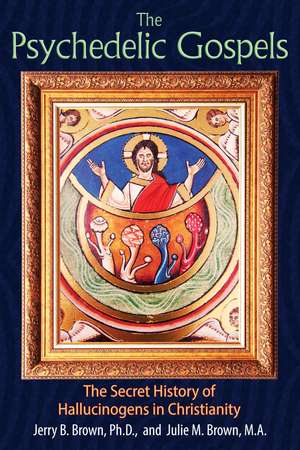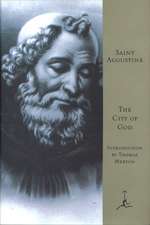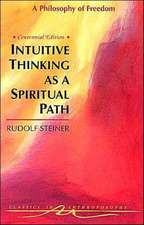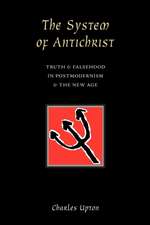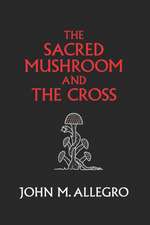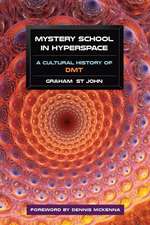The Psychedelic Gospels: The Secret History of Hallucinogens in Christianity
Autor Jerry B. Brown Ph.D., Julie M. Brown M.A.en Limba Engleză Paperback – 19 oct 2016
Providing stunning visual evidence from their anthropological journey throughout Europe and the Middle East, including visits to Roslyn Chapel and Chartres Cathedral, authors Julie and Jerry Brown document the role of visionary plants in Christianity. They retrace the pioneering research of R. Gordon Wasson, the famous “sacred mushroom seeker,” on psychedelics in ancient Greece and India, and among the present-day reindeer herders of Siberia and the Mazatecs of Mexico. Challenging Wasson’s legacy, the authors reveal his secret relationship with the Vatican that led to Wasson’s refusal to pursue his hallucinogen theory into the hallowed halls of Christianity.
Preț: 115.27 lei
Nou
22.06€ • 23.09$ • 18.36£
Carte disponibilă
Livrare economică 10-24 martie
Specificații
ISBN-10: 1620555026
Pagini: 288
Ilustrații: Includes 16-page color insert and 30 b&w illustrations
Dimensiuni: 152 x 229 x 18 mm
Greutate: 0.45 kg
Editura: Inner Traditions/Bear & Company
Colecția Park Street Press
Notă biografică
Jerry B. Brown, Ph.D., is an educator, anthropologist and activist. From 1972 to 2014 he served as founding professor of anthropology at Florida International University in Miami, where he taught a course on “Hallucinogens and Culture.” Julie M. Brown, M.A., is a holistic psychotherapist and health coach, who researches the role of sacred plants in religion.
Extras
The Prophet Has Spoken Nohant-Vic, France--1120
The Church of St. Martin sat unpretentiously amidst a cluster of modest two-story stone homes with pitched roofs; their terracotta tiles glistened with the light rain.
A plaque in the parking lot described the murals as “the work of an artist of genius, which portrays the theme of Redemption, from the Error of Adam to the Last Judgment.”
Stepping across the threshold was like having cataracts removed from your eyes and suddenly seeing in vibrant color and high-definition. Here the rich red, ochre, and white hues of the nativity scenes in the nave were a prelude to the panoply of powerful paintings that filled the choir in the adjoining room.
Once inside, Julie and I were enchanted by the majestic visual feast of frescos guarded over by rosy-cheeked seraphim. The church bells began to peal, transporting us back to medieval times. Julie took my arm and turned me around to look at the wall-length panel ofChrist’s Entry into Jerusalem. “Do you see what I see?” she asked in amazement. There was no way I could miss the smooth caps of five psilocybin mushrooms. The brown-and-white colored caps gracefully spread out over the heads of the three joyful youth welcoming Jesus into the city for his
messianic date with destiny.
“Look how big these mushrooms are, as big as the heads of the young men,” Julie noted.
“Size matters in Romanesque art,” I replied, “because the painter is calling our attention to its importance.”
“Now step back and tell me exactly what you see,” I said. She spoke slowly, while rapidly clicking photos, as if she were rushing to capture these images before they could disappear, even though they had been here for nearly a thousand years.
“I see a man kneeling before a much larger robed figure, possibly an angel entering the scene from above, whose body is bathed in concentric circles of light. There is a hand coming out of the light. Between the thumb and index finger is a tan, roundish object that is being offered to the man who is looking up in awe.”
“Anything else?” I inquired.
“Yes, the robes of the angel and of the kneeling man, and the border below them, are painted sky blue. This color also tints the robes of Jesus’s disciple.”
“Why do you think that’s Jesus?” I asked.
“Because he’s riding on an ass, which is how the Bible depicts his entry into Jerusalem at Passover. Walking directly behind Jesus are two men holding their arms up in the gesture of standing in awe. Jesus is sitting on an ass with his arms reaching out toward the youths who are greeting him. One of the youths is leaning forward, holding on to the stem of an oblong mushroom in his left hand, while offering Jesus, with his right hand, three stems whose tops have been painted over or somehow obscured.”
“While the youth holding the mushroom is wearing a cape, the two youths below have taken off their capes, unfolding them to welcome Jesus as if rolling out a royal carpet. The furls in the capes extend all the way below the figure of Jesus and are repeated in the robes of the disciples as well as in the robes of the kneeling man and the angel, visually tying both scenes together.”
Julie turned to the right and said, “Jesus and his disciples are traveling toward the gates of Jerusalem, where a rotund man on top of the tower is using a long knife to cut through the stem of a mushroom. It’s the same shape and color as the mushrooms in the last scene. These towers are adjacent to the scene of theLast Supper, where Jesus and eleven of his disciples are gathered behind the table, while the twelfth disciple, probably Judas, is kneeling on the other side.”
“Jesus is extending a very long arm toward Judas’s mouth, holding something in his fingers out to Judas, similar to the way the angel is holding something out to Isaiah. I can’t tell what it is. But, look, there are four long knives on the table, just like the one used to cut down the mushrooms in the adjoining tower scene!”
“Isn’t the Last Supper supposed to be a Passover meal?” I asked.
“This is definitely not a Passover Seder, because there is no Pascal lamb or wine goblets, only bowls and round objects,” Julie pointed out. “In fact, the mushroom caps being cut on top of the tower and the objects on the table share the same round form, size, and coloration. This repetition of mushroom caps and knives connects the scenes visually and also suggests a sequence from the cutting of the mushroom caps to their later appearance on the table. And, look at the way in which the table itself is rotated forward so that it’s parallel with the plane of the entire picture. In combining scale--the large size of the mushroom caps--and perspective, the artist is calling attention to the objects on the table.”
Julie grabbed her camera, zoomed in on theLast Supper, and then passed the camera to me, telling me to look closely at the robes of the disciples seated to the left of Jesus. To my surprise, neatly drawn into the folds of their hems were four umbrella-shaped psilocybin mushrooms caps whose stems were all linked together.
“Look!” I said, “There’s also a mushroom in the hem of the disciple directly to the right of Jesus as well as two more at the tip of Judas’ robe. The artist painted the mushrooms into the folds, as if trying to disguise them. These mushroom hems are neatly aligned because the artist is telling us how important they are--a way of informing initiates that entheogens were present at the Last Supper.”
Cuprins
Acknowledgments
PREFACE
An Invitation to Readers
Map of Churches and Sacred Sites Visited
Sacred Mushroom Seeker
R. Gordon Wasson (1898-1986)
PART ONE
The First Religion
1 Green Man of Rosslyn Chapel
Roslin, Scotland-1446
2 O Immortal Soma!
Indus River Valley, India-1400 BCE
3 Santa, the Reindeer Shaman
Siberia, Russia-2000 BCE
4 Eleusinian Mysteries
Greece-1500 BCE
5 María Sabina and the Little Saints
Mexico-1955
6 Miracle of Marsh Chapel
America-1962
PART TWO
Hidden in Plain Sight
7 Battle of the Trees
Mérigny, France-1291
8 The Prophet Has Spoken
Nohant-Vic, France-1120
9 Down the Rabbit Hole
Rennes le Château, France-1891
10 Canterbury Tales
Canterbury Cathedral, England-1180
11 Saint Bernward’s Secret
Hildesheim, Germany-1015
PART THREE
Cosmic Consciousness
12 The Pope’s Banker
Aquileia, Italy-330
13 The Dark Church
Cappadocia, Turkey-1050
14 Kingdom of Heaven
Jerusalem-30
15 Psychedelic Renaissance
America-2015
APPENDIX
Interdisciplinary Committee on the Psychedelic Gospels
Recenzii
“I found this book to be a compelling, entertaining account of one couple’s quest for the hallucinogenic Holy Grail--a mind-altering travelogue across continents and conspiracy theories. It’s The Da Vinci Code meets The Electric Kool-Aid Acid Test.”
“. . . possibly uncovers one of the most secret, historical findings of our times--the influence of psychedelics as an integral part of the early Christian experience. . . . bold, courageous, and insightful. A must read!”
“The Psychedelic Gospels is heretical, revolutionary, and outrageous. It claims that there is a direct relationship between the founding and development of Western religions and psychoactive substances and that this is a continuation of an amalgamation of many mind-altering practices and fertility cults found in the Middle East. The scholarship behind these provocative perspectives is impressive, and the hidden subtexts of Christian art are compelling.”
“Mushrooms, mushrooms, mushrooms. Once you start looking you see them everywhere. Keep your mind open. Wider!”
“We live at a time when confused and undisciplined thinking clashes with narrow-minded bigotry. Thus, it is more important than ever to keep an open mind—open to new ideas, open also to rigorous scholarship. Too often, wishful thinking has misled well-intentioned academics, and the media are notorious for sensationalism. I, therefore, applaud the authors for proposing the establishment of an interdisciplinary committee to evaluate the discoveries they present and the conjectures they make in The Psychedelic Gospels.”
“This book expertly navigates through the iconography of mushroom symbolism throughout the ages. One clear message comes through: mushrooms have played a central role in the evolution of human consciousness and, indeed, religion. Thought provoking and well articulated, the authors present a solid case for their thesis. This is an important book to contemplate.”
“Part travelogue, part anthropological meditation, and part groundbreaking study showing the use of sacred mushrooms in Christian iconography, The Psychedelic Gospels gives readers one of the most unusual books they will ever encounter. Jerry and Julie Brown present a lively account of a psychedelic theory of religion and tell us why it’s been suppressed for so many years.”
“Impeccably researched and lavishly illustrated, The Psychedelic Gospels reads like a page-turning mystery thriller. An interdisciplinary treasure chest overflowing with rare information, unique insights, and some truly extraordinary head-slapping ‘aha’ moments. The authors present a compelling case for the influence of entheogens among early Christians.”
“The authors make obvious and pleasant the idea that there was a high degree of psychedelic use in the early Christian church, far from the exoteric component, something mysterious kept for the initiated few, which might arouse some anger at the system that kept it from their beloved faithful.”
“A fascinating piece of scholarly work that opens new possibilities of understanding human consciousness.”
"The Psychedelic Gospels is fast paced, well illustrated, and serves up a rich buffet for those believing that the roots of Christianity are fungal. A fun feast for true believers and skeptics alike"
Descriere
Providing stunning visual evidence from their anthropological journey throughout Europe and the Middle East, including visits to Roslyn Chapel and Chartres Cathedral, authors Julie and Jerry Brown document the role of visionary plants in Christianity. They retrace the pioneering research of R. Gordon Wasson, the famous “sacred mushroom seeker,” on psychedelics in ancient Greece and India, and among the present-day reindeer herders of Siberia and the Mazatecs of Mexico. Challenging Wasson’s legacy, the authors reveal his secret relationship with the Vatican that led to Wasson’s refusal to pursue his hallucinogen theory into the hallowed halls of Christianity.
